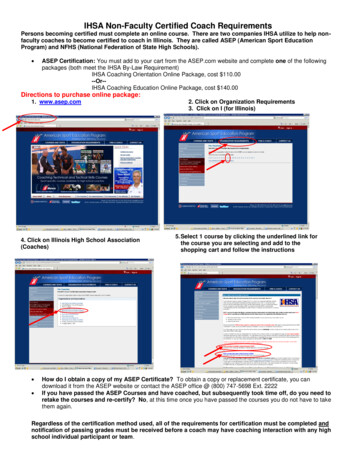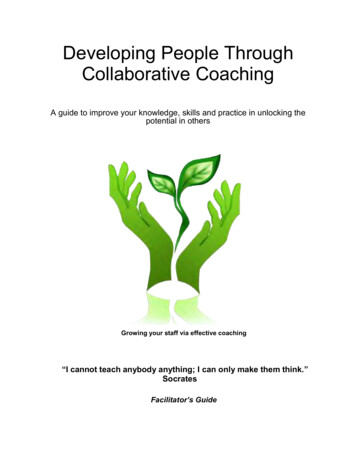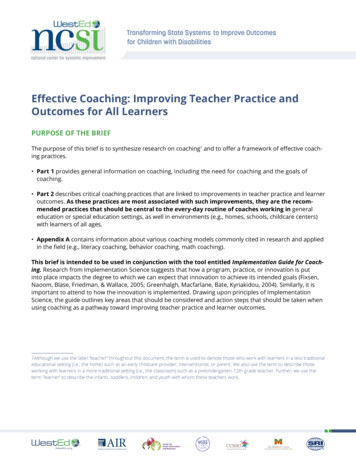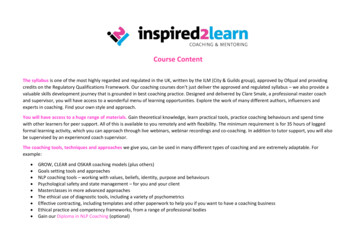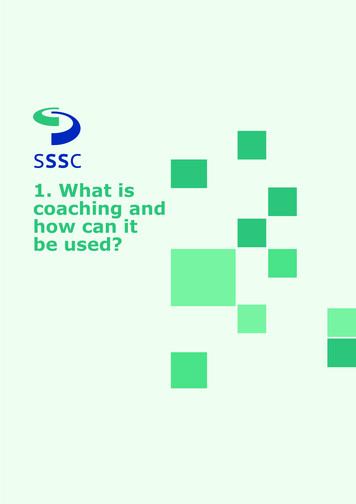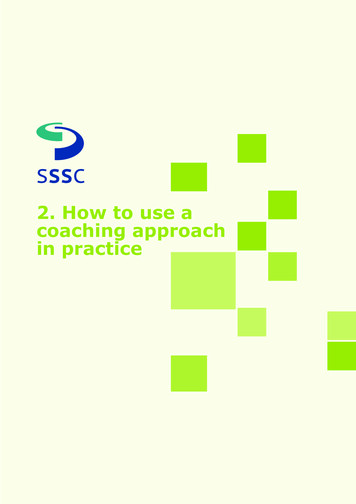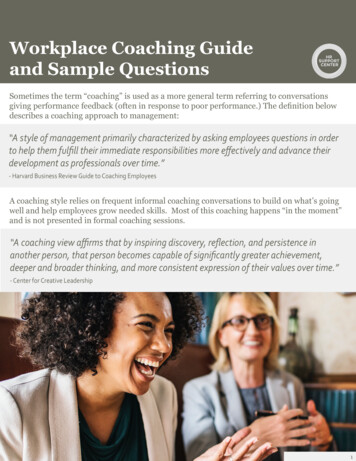
Transcription
Workplace Coaching Guideand Sample QuestionsSometimes the term “coaching” is used as a more general term referring to conversationsgiving performance feedback (often in response to poor performance.) The definition belowdescribes a coaching approach to management:“A style of management primarily characterized by asking employees questions in orderto help them fulfill their immediate responsibilities more effectively and advance theirdevelopment as professionals over time.”- Harvard Business Review Guide to Coaching EmployeesA coaching style relies on frequent informal coaching conversations to build on what’s goingwell and help employees grow needed skills. Most of this coaching happens “in the moment”and is not presented in formal coaching sessions.“A coaching view affirms that by inspiring discovery, reflection, and persistence inanother person, that person becomes capable of significantly greater achievement,deeper and broader thinking, and more consistent expression of their values over time.”- Center for Creative Leadership1
Studies have shown that a coaching style of management can create greater employeeengagement and commitment, improve performance, and accelerate talent development.When employees are coached, they feel supported and encouraged by their manager andthe company. Retention can improve as employees are more loyal and motivated when theirsupervisors take time to help them improve their skills.Trust is an essential ingredient in coaching relationships. Trust enables the employee to beopen to the lessons that come from coaching. Trust means that an employee will believe theirmanager is providing coaching for the purpose of development and not just as a means ofgetting the job done. Without trust, employees likely won’t be fully truthful about their goalsand weaknesses or about how they see their role in the organization.For best results using a coaching management style, you will also shift to a “growth mindset.”If you have ever found yourself thinking “My employee will never be able to accomplishthis task” or “He just doesn’t get it” then you were thinking with a “fixed mindset.” Lowexpectations severely limit your ability to coach an employee. While there are people who areunable (or unwilling) to develop, often the barrier is the manager’s belief that a person won’tmake progress or succeed. A fixed mindset leads a manager to do things like not delegate, dothings that the team could do, and provide answers instead of allowing the team to learn bydoing.Adopting a growth mindset means that you focus feedback, both positive and corrective,on employee’s efforts to achieve their goals, and not on their inherent abilities. When anemployee missteps, rather than viewing this as a “failure,” or assuming they aren’t capable ofdoing the job, you focus on helping the employee learn from the experience and understandhow doing something differently could have resulted in success. This helps ensure differentresults in the future.2
Coaching - it’s all about questions!Instead of giving the employee the solution to a problem (more of a “command and control”style), with a coaching style, you assume the employee has the wisdom within to come toanswers on their own. Sometimes you may know a possible answer, but sometimes, as isthe case with employees who handle very specific technical information, you may not. Witha coaching approach you ask instead of advise as much as possible. Many times when youprovide an answer, you limit the possible outcomes and miss growth opportunities.Here are tips for using coaching questions:Use mainly open-ended questions (cannot be answered with “yes” or “no”). This type ofquestion cannot be easily answered. There is no “right” or “wrong” answer. Open-endedquestions cause an employee to think critically about the answer and new possibilities.Keep questions broad and expansive (not “problem solving”). Ask general questions. Themore specific the question is, the more it may appear you are leading the employee toward aparticular outcome.For example: “What do you hope to accomplish with this presentation?” and then if theresponse is “Demonstrate that our product is the best choice for the client.” Respond with“What might you change in the presentation to better reach your goal?” or “On a scale of 1to 10, how well do you think the presentation does that? How can you make it a 10?” This isinstead of a narrower question like “What slides could you delete to make the presentationmore effective?” or “Have you thought about [manager idea for improvement]?” Whenemployees participate in finding the solution, they are much more likely to learn from thesituation and take ownership of the results.In general, avoid questions that start with “Why.” Questions that begin with “Why” can oftensound accusatory and make an employee feel defensive.For example: “Tell me about your thought process” instead of “Why did/didn’t you do[something?]” The first sentence assumes a positive intent and comes across as curious andnon-judgmental. The employee is more likely to feel comfortable expressing what happenedthan with the second sentence which can imply that the decision they made was not correctand put the employee on the defensive.3
Keep the mindset that the employee has the solution, and the manager’s role is to facilitatetheir finding the wisdom within. Resist the urge to tell the employee how to do something.Allow the employee to think through things on their own. Ask thought provoking questionsbefore you provide advice. Allowing the employee to come to their own solution will facilitatetheir development, allow them to learn more than if you tell them what to do, create employee“buy in” to the solution, and allow you to remain open to other possible ways of doing things.Assume a positive intent. Appear curious, not critical. Even in the face of what appears to bea negative situation, allow yourself to remain open to other perspectives. You may learn therewas a perfectly logical reason for the employee to do what they did. It may be that somethingthat first appears negative on the surface actually has a more neutral or positive outcome. Ifthe situation didn’t work out well, but there was a logical and positive reason behind it, focuson the learning in the situation.Listen more than you talk, allow the employee to really feel “heard.” This is a strategy thatbuilds trust with employees. You are also allowing the employee to find the solution instead ofgiving it to them.Don’t say what you would have done differently. A coaching mindset recognizes that thereare many ways to get a job done and many different work styles that can all be effective. Yourgoal is not to create another version of you. Focusing too much on your own personal workstyle can be limiting.Don’t interrupt, be distracted or focus on what you will say next. Being fully present with theemployee will show that you care about the employee and help establish trust.Using a coaching style can work well when you want to focus on short- and long-termemployee development or performance improvement. It’s not an end-all-be-all solution andthere will be times that you need to use a different approach. For example, misconduct istypically better addressed with more formal disciplinary processes. In some situations it isbetter to provide clear and actionable praise and corrective feedback. There are also timeswhen a manager needs to use a more directive style of management. Clear direction canbe required, for example, when an organization is changing course and the leader needs tomotivate employees around the new vision, where rapid results are required, or in times ofcrisis or extreme change.4
Sample Coaching Questions»» Tell me more about that. (When the person hasn’t provided details oryou don’t thoroughly understand the situation.)»» Help me to understand (Provides clarity on something; Puts theresponsibility on the manager for not having understood.)»» Tell me more about why you feel this way. (You can reflect “You saidyou don’t think that you are as challenged as you would like to be. Tellme more about why you feel this way.”)»» What’s holding you back?»» What is happening right now around [this issue]?»» What have you done so far?»» What effect did it have?»» What is your goal/desired outcome in this situation?»» How would achieving this goal matter to the organization? (testswhether the goal is the best one to focus on in light of strategic goals.)»» What do you propose?»» What is your plan?»» What are some different ways that you might approach this situation?»» What are some ways that you could make [stated desired result]happen?»» What could be your next step?»» What options do you have?»» What would happen if you do nothing? (Helps solve the problem by“not solving” it.)»» What has worked well in similar situations in the past? or How haveyou solved a similar problem in the past? (Works well if person is stuckon how to reach a goal.)»» What are the costs and benefits (or pros and cons) of each approach?»» What approach seems most effective to you in reaching your goal?»» What else do you need to consider?»» What is the goal of the meeting? How can you ensure that youaccomplish it?»» What impact do you think this presentation will have? What changesmight you make for it to have more impact?5
»» What is your desired message? How effective do you think this [newsstory, grant proposal, presentation, etc.] is at communicating it?»» What is the worst that could happen? (When someone is resistant toa particular action, this gets them to realize that the worst that couldhappen is not actually that bad.)»» What can you control in this situation? (useful where an employee istalking about something or someone they disagree with; helps them tofocus on how they can change their approach.)»» How can you take responsibility for your role in this situation? (Usefulwhen employee pointing blame at others and not owning their role.)»» What evidence do you have to support that? (Can be useful if theemployee is expressing a limiting negative belief or making anassumption that something will fail. The questions helps pointout contrary and more positive points of view. For example, use inresponse to things like: This project will never work. No one in theaccounting department respects my opinion.)»» What do you know for sure? (Similar to the question above, encouragesemployee to drop a subjective interpretation and take a more objectivelook at a situation.)»» What’s another way that you could look at that?»» What might another interpretation of that situation be?»» What do you think is really causing this situation?»» What will an indicator of success be?»» What will a successful final outcome look like?»» How will you measure success?»» Envision that you are finished with this. Describe the final product.What steps do you need to take to get there?»» How will you know if you’ve succeeded on [this project]?»» What do you need to do to achieve your goal?»» What will it take for you to be successful on [this project]?»» Whose input is necessary to ensure the project is successful?»» Who are the stakeholders for this project?»» Who could negatively impact this project? How?»» Who could positively impact this project? How?»» If you will finish the project on time, what tasks do you need toconcentrate on in the short term?6
»» If you need to complete this project by January 10th, what steps needto be finished immediately to ensure that happens? (Also, workingbackwards and breaking a large goal into smaller parts by askingquestions about what needs to be accomplished and by when. Oftenemployees need help breaking down large projects into manageableparts. Ensure that the action items and dates they are committing toare attainable/realistic.)»» How attainable is that goal?»» What actions do you need to take to get to your goal?»» What specific steps do you need to take to reach your goal?»» What might get in the way of your completing these steps?»» What can you do to ensure success? How will you do that?»» When will you do that?»» When should I follow up with you on this?»» Who needs to know about this and how will you inform them?»» What do you need from me right now?»» What would you do if you knew that you couldn’t fail?»» What areas do you want to strengthen, improve or develop?»» How will you benefit from developing this skill?»» What resources are available to you?»» If you started this project today, knowing what you know now, whatwould you do differently?»» What can you learn from this situation? or How can you view this as alearning experience?»» How can you double the number of [people impacted by our services,clients, audience that sees your message, etc.]?»» How could you turn this around in time?»» What can you delegate to others?»» What is working well right now?»» On a scale from one to ten, what is the likelihood of your plansucceeding? How would you rate your presentation (or project, etc.)?What would it take to make it a ten?Legal Disclaimer: This document is intended for informational purposes only and was created in accordance withfederal law; it may not encompass state or local law.7
giving performance feedback (often in response to poor performance.) The definition below describes a coaching approach to management: A coaching style relies on frequent informal coaching conversations to build on what’s going well and help employees grow needed skills. Most

